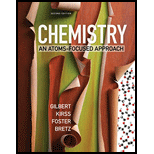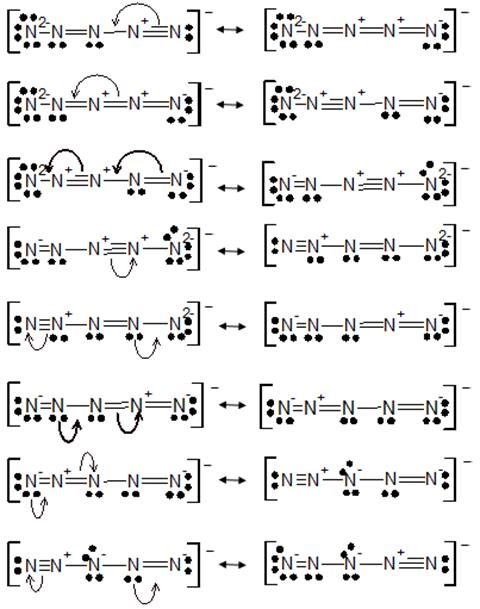
To draw:
a) The Lewis structures for four resonance forms of linear N5-.
b) Calculate formal charges and identify the structures that contribute the most to the bonding in N5-.
c) By comparing Lewis structures for N5- and N3-, find out the ion in which the nitrogen-nitrogen bonds have the higher average bond order.
Answer to Problem 4.169QA
Solution:
a)

b) The last four structures having the lowest formal charge. These structures contribute the most to the bonding in N5-.
c)
![]()
From these resonance structures we see that each bond is predicted to be of double bond character in N3-. Therefore, in N5- there are two longer nitrogen-nitrogen bonds than in N3-. N3- has the higher average bond order.
Explanation of Solution
The ground state electronic configuration of N is 1s2 2s2 2p3.
| Element | Valence electrons | ||
| Symbol | # of atoms | In one atom | Total |
| N | 5 | 5 | 25 |
| One electron from -1 charge | 1 | ||
| Valence electrons in molecule | 26 | ||
Each N atom is attached with single bond.
N - N - N - N - N
Eight electrons get involved in the bond formation. Now we put remaining electrons as lone pairs on the atoms.
![]()
The octet of terminal N atoms is get completed. The octet of remaining N is not get completed. For that we will convert some lone pairs into bond pairs.

Now we calculate the formal charge on each atom in second structure.
The Lewis structure with formal charge on N atom is as follows.

![]()
Now we draw the resonating structures of this molecule.

The molecules which having minimum formal charge will contribute the most to the bonding in N5-. Following structures having least formal charge and will contribute the most to the bonding in N5-.
![]()
![]()
![]()
![]()
Let’s we draw the Lewis structure of N3-.
| Element | Valence electrons | ||
| Symbol | # of atoms | In one atom | Total |
| N | 3 | 5 | 15 |
| One electron from -1 charge | 1 | ||
| Valence electrons in molecule | 16 | ||
![]()
From these resonance structures we see that each bond is predicted to be of double bond character. Therefore, in N5- there are two longer nitrogen-nitrogen bonds than in N3-.
Bond order is the number of bonds between atoms. For single bond the bond order is 1. For double bond the bond order is 2. For triple bond the bond order is 3. From the resonance structure of N5- and N3-, we can say that N3- has the higher average bond order.
Conclusion:
From the electronic configuration of atoms in the molecule we can draw Lewis structure of the molecule. From the Lewis structure we can find out formal charge and bond order.
Want to see more full solutions like this?
Chapter 4 Solutions
Chemistry: An Atoms-Focused Approach (Second Edition)
- H CH3 CH3 b) Write the products of your compound and the following reagents. If the reaction would not work for your compound, write "no reaction" and explain the problem. NaCN H* H₂NNHCH5 H* -à NaBH -à CH2MgBr Cro₁₂ --à H3O+ -à c) Would your compound give a positive Tollen's test? Why or why not?arrow_forwardHomework 4 Chem 204 Dr. Hellwig Consider this compound, which will be referred to as "your compound". a) Name your compound according to the IUPAC system. Include stereochemistry (E/Z/R/S) H CH3 CH3arrow_forwardWhat is the mechanism for this?arrow_forward
- 21.50 Determine the combinations of haloalkane(s) and alkoxide(s) that could be used to synthesize the following ethers through Williamson ether synthesis. (a) (c) (d) (e) (f) H₂COarrow_forward1. Arrange the following in order of increasing bond energy (lowest bond energy first, highest bond energy last). Provide your rationale. C=C, C-F, C=C, C-N, C-C List the bond order for each example.arrow_forwardWhat is the major enolate formed when treated with LDA? And why that one?arrow_forward
- 4. Calculate the total number of sigma bonds and total number of pi bonds in each of the following compounds. a. HH :D: +1 I H-N-C-C-O-H I H b. HH H Н :N=C-C-C=C-CEC-H :0: total o H-C-H H-C = `C-H I H. 11 H-C = C= CH H total o total π total π 1 Harrow_forwardIn the following reaction, what quantity in moles of CH₃OH are required to give off 4111 kJ of heat? 2 CH₃OH (l) + 3 O₂ (g) → 2 CO₂ (g) + 4 H₂O(g) ∆H° = -1280. kJarrow_forwardIndicate the processes in the dismutation of Cu2O.arrow_forward
- 1. Consider these three reactions as the elementary steps in the mechanism for a chemical reaction. 2600 2400 2200 2000 1800 1600 1400 1200 1000 800 Potential Energy (kJ) 600 400 200 0 -200- -400 -600- -800 (i) Cl₂ (g) + Pt(s) → 2Cl (g) + Pt(s) (ii) Cl (g)+ CO (g) + Pt (s) → CICO (g) + Pt (s) Ea = 1550 kJ Ea = 2240 kJ (iii) Cl (g) + CICO (g) → Cl₂CO (g) Ea = 2350 kJ AH=-950 kJ ΔΗ = 575 ΚΙ AH=-825 kJ a. Draw the potential energy diagram for the reaction. Label the data points for clarity. The potential energy of the reactants is 600 kJ Reaction Progress b. What is the overall chemical equation? c. What is the overall change in enthalpy for the above chemical reaction? d. What is the overall amount of activation energy for the above chemical reaction? e. Which reaction intermediate would be considered a catalyst (if any) and why? f. If you were to add 2700kJ of energy to the reaction (e.g. 2700 kl of heat or electricity), would you be able to make the reaction reverse itself (i.e. have…arrow_forwarddraw the enolate anion and the carbonyl that would be needed to make this product through an aldol addition reaction.arrow_forwardDraw the Michael Adduct and the final product of the Robinson annulation reaction. Ignore inorganic byproducts.arrow_forward
 ChemistryChemistryISBN:9781305957404Author:Steven S. Zumdahl, Susan A. Zumdahl, Donald J. DeCostePublisher:Cengage Learning
ChemistryChemistryISBN:9781305957404Author:Steven S. Zumdahl, Susan A. Zumdahl, Donald J. DeCostePublisher:Cengage Learning ChemistryChemistryISBN:9781259911156Author:Raymond Chang Dr., Jason Overby ProfessorPublisher:McGraw-Hill Education
ChemistryChemistryISBN:9781259911156Author:Raymond Chang Dr., Jason Overby ProfessorPublisher:McGraw-Hill Education Principles of Instrumental AnalysisChemistryISBN:9781305577213Author:Douglas A. Skoog, F. James Holler, Stanley R. CrouchPublisher:Cengage Learning
Principles of Instrumental AnalysisChemistryISBN:9781305577213Author:Douglas A. Skoog, F. James Holler, Stanley R. CrouchPublisher:Cengage Learning Organic ChemistryChemistryISBN:9780078021558Author:Janice Gorzynski Smith Dr.Publisher:McGraw-Hill Education
Organic ChemistryChemistryISBN:9780078021558Author:Janice Gorzynski Smith Dr.Publisher:McGraw-Hill Education Chemistry: Principles and ReactionsChemistryISBN:9781305079373Author:William L. Masterton, Cecile N. HurleyPublisher:Cengage Learning
Chemistry: Principles and ReactionsChemistryISBN:9781305079373Author:William L. Masterton, Cecile N. HurleyPublisher:Cengage Learning Elementary Principles of Chemical Processes, Bind...ChemistryISBN:9781118431221Author:Richard M. Felder, Ronald W. Rousseau, Lisa G. BullardPublisher:WILEY
Elementary Principles of Chemical Processes, Bind...ChemistryISBN:9781118431221Author:Richard M. Felder, Ronald W. Rousseau, Lisa G. BullardPublisher:WILEY





